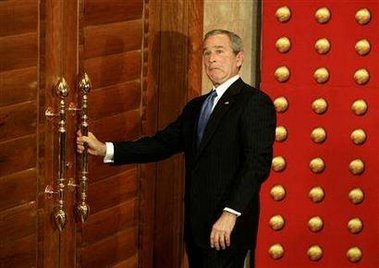 The prosthetic Cyberhand aims to be the world's first to provide senses for its user and to be "controlled using the efferent neural signals coming from the central nervous system." That means it'll be hardwired into the nervous system so the brain can prompt use of the limb. As Physorg.com reports, it includes six motors for movement, an opposable thumb, and "sensors for tension, force, joint angle, end stroke and contact." Right now, Cyberhand is just a prototype but clinical validation will begin in '06.
The prosthetic Cyberhand aims to be the world's first to provide senses for its user and to be "controlled using the efferent neural signals coming from the central nervous system." That means it'll be hardwired into the nervous system so the brain can prompt use of the limb. As Physorg.com reports, it includes six motors for movement, an opposable thumb, and "sensors for tension, force, joint angle, end stroke and contact." Right now, Cyberhand is just a prototype but clinical validation will begin in '06.
11.30.2005
High(tech) Five
 The prosthetic Cyberhand aims to be the world's first to provide senses for its user and to be "controlled using the efferent neural signals coming from the central nervous system." That means it'll be hardwired into the nervous system so the brain can prompt use of the limb. As Physorg.com reports, it includes six motors for movement, an opposable thumb, and "sensors for tension, force, joint angle, end stroke and contact." Right now, Cyberhand is just a prototype but clinical validation will begin in '06.
The prosthetic Cyberhand aims to be the world's first to provide senses for its user and to be "controlled using the efferent neural signals coming from the central nervous system." That means it'll be hardwired into the nervous system so the brain can prompt use of the limb. As Physorg.com reports, it includes six motors for movement, an opposable thumb, and "sensors for tension, force, joint angle, end stroke and contact." Right now, Cyberhand is just a prototype but clinical validation will begin in '06.
Face plant
Back in February 2003, I linked to a story about a girl getting the first ever face transplant. Now the BBC reports of another first face transplant (maybe the first one didn't, er, stick?). A French woman who lost her nose, lips, and chin in a dog attack will get the skin, fat, and blood vessels from a recently deceased donor grafted to her lower face. Medical risks aside, it presents new ethical conundrums. Iain Hutchison of Saving Faces - the Facial Surgery Research Foundation, says, "The transplant would have to come from a beating heart donor. So, say your sister was in intensive care, you would have to agree to allow their face to be removed before the ventilator was switched off. And there is the possibility that the donor would then carry on breathing."
Thanks for the links
And welcome readers from Digg (12/4), Kottke.org, Robot Wisdom, Modern Art Notes, things magazine, and A Welsh View.
Guerrilla Guernica
 John T. Unger proposes a simple open-source street art project, American Guernica. He urges people across the country to put up billboard-sized reproductions of Picasso's famous interpretation of the decimation of an ancient Basque city, sans text or other identifying information. "[I]f the painting is all that's seen, it forces the viewer to make an interpretation instead of being told what to think. Being told what to think is exactly what got Americans in trouble in the first place, no?"
John T. Unger proposes a simple open-source street art project, American Guernica. He urges people across the country to put up billboard-sized reproductions of Picasso's famous interpretation of the decimation of an ancient Basque city, sans text or other identifying information. "[I]f the painting is all that's seen, it forces the viewer to make an interpretation instead of being told what to think. Being told what to think is exactly what got Americans in trouble in the first place, no?" It's a great idea, albeit expensive. Since he made his initial post on it in October, I wonder if anyone has installed guerilla pieces anywhere...
(Via Collision Detection via reBlog.)
Headlines
You get better news this way: "As part of an information offensive in Iraq, the U.S. military is secretly paying Iraqi newspapers to publish stories written by American troops in an effort to burnish the image of the U.S. mission in Iraq," reports The Los Angeles Times.
None too soon: Two years and none months into it and 2110 dead military personnel later, the White House announces its "National Strategy for Victory in Iraq" this morning. Just a few days ago, Colin Powell's former chief of staff, Col Lawrence Wilkerson, called the White House's post-invasion planning "as inept and incompetent as perhaps any planning anyone has ever done."
UK abets CIA terror flights? The Times Online reports on "potentially devastating allegations" that the British government participated in the US' practice of flying suspected terrorists to "black site" prisons in countries where torture is not prohibited. According to the human rights group Liberty, which threatens legal action if investigations into the practice aren't begun in earnest, "[f]light records show that at least 210 private jets carrying detainees apparently leased by shell companies attached to the CIA have stopped over in the UK since September 2001." The EU is already seeking answers from the Bush administration about the alleged use of such sites in eastern Europe.
Changing the Subject: With a bungled war, a GOP that's fast losing favor, and corruption throughout the party, you might think that the highest ranking House Republican would have something better to focus on than to work at renaming the Capitol "Holiday Tree" the "Capitol Christmas Tree." All these war-on-Christmas zealots seem to forget that the conifer used in celebrations of Christ's birth was actually nicked (pun intended) from pagan tradition.
None too soon: Two years and none months into it and 2110 dead military personnel later, the White House announces its "National Strategy for Victory in Iraq" this morning. Just a few days ago, Colin Powell's former chief of staff, Col Lawrence Wilkerson, called the White House's post-invasion planning "as inept and incompetent as perhaps any planning anyone has ever done."
UK abets CIA terror flights? The Times Online reports on "potentially devastating allegations" that the British government participated in the US' practice of flying suspected terrorists to "black site" prisons in countries where torture is not prohibited. According to the human rights group Liberty, which threatens legal action if investigations into the practice aren't begun in earnest, "[f]light records show that at least 210 private jets carrying detainees apparently leased by shell companies attached to the CIA have stopped over in the UK since September 2001." The EU is already seeking answers from the Bush administration about the alleged use of such sites in eastern Europe.
Changing the Subject: With a bungled war, a GOP that's fast losing favor, and corruption throughout the party, you might think that the highest ranking House Republican would have something better to focus on than to work at renaming the Capitol "Holiday Tree" the "Capitol Christmas Tree." All these war-on-Christmas zealots seem to forget that the conifer used in celebrations of Christ's birth was actually nicked (pun intended) from pagan tradition.
11.29.2005
"Censorship" in Poland
 From NewsDesigner.com:
From NewsDesigner.com:Poland's two largest newspapers, Gazeta Wyborcza and Rzeczpospolita, joined an Amnesty International protest against repression in neighboring Belarus on Wednesday and blacked out much of their front pages. An Amnesty ad on the bottom read "This is what freedom of speech looks like in Belarus." The uncensored front pages ran on page 3 [...] with news and commentary on humans rights abuses in Belarus.(Via Norwegianity.)
CPR for dummies.
The American Heart Association has radically modified its CPR instructions, reports USA TODAY:
Call for help. Push the chest. Don't stop.
Two rescue breaths can be given after every 30 compressions, but mouth-to-mouth is optional.
"Some CPR is better than no CPR," says Robert O'Connor of Christiana Care Health System in Newark, another guideline author. Until emergency medical responders arrive, chest compressions alone can often be just as effective in saving a life, he says.
Spoofing officialdom.
11.28.2005
Eye Level
As I wrote at Off Center the Smithsonian Museum of American Art has started a blog, with Grammar.police's Kriston Capps at the helm. The more the merrier!
The Right, so wrong.
 A woman's son is killed serving the US in Iraq, and this is what the pro-war right has to say about it. This is Jay D. Dyson's A Crawford Thanksgiving. As Peek reports, a sign bearing this image was held by a 12-year old at a pro-Bush rally outside the family ranch where Cindy Sheehan is again protesting.
A woman's son is killed serving the US in Iraq, and this is what the pro-war right has to say about it. This is Jay D. Dyson's A Crawford Thanksgiving. As Peek reports, a sign bearing this image was held by a 12-year old at a pro-Bush rally outside the family ranch where Cindy Sheehan is again protesting.
Welcome mat
 When the prez arrives in Denver for his visit with Republican Marilyn Musgrave tomorrow, this is what'll welcome him. Designed by Denver native Adam Mordecai, the smart billboard is the winner of Progress Now Action's Bush-Musgrave Billboard Contest. Peek has more.
When the prez arrives in Denver for his visit with Republican Marilyn Musgrave tomorrow, this is what'll welcome him. Designed by Denver native Adam Mordecai, the smart billboard is the winner of Progress Now Action's Bush-Musgrave Billboard Contest. Peek has more.
Virtual air guitar
 The "No Stairway" rule oughta still apply: students at the Helsinki University of Technology have created a way for air-guitar virtuosos to make music without taking a lesson:
The "No Stairway" rule oughta still apply: students at the Helsinki University of Technology have created a way for air-guitar virtuosos to make music without taking a lesson:Using a computer to monitor the hand movements of a "player", the system adds riffs and licks to match frantic mid-air finger work. By responding instantly to a wide variety of gestures it promises to turn even the least musically gifted air guitarist to a virtual fret board virtuoso.More from New Scientist.
Advice from Charles Beard
 My coworker Adrienne forwards yesterday's edition of the Writer's Almanac (listen here; scroll down to November 27). Of particular interest is this historical fact:
My coworker Adrienne forwards yesterday's edition of the Writer's Almanac (listen here; scroll down to November 27). Of particular interest is this historical fact:It's the birthday of the historian Charles Beard, born near Knightstown, Indiana (1874). He was one of the most controversial historians of his day, in part because he refused to accept the myths passed down about the nobility of the founding fathers. In one of his first important books, An Economic Interpretation of the Constitution of the United States, (1913) he uncovered the records of personal holdings of government securities by the framers of the constitution, and he found that they all got rich when the constitution was adopted.[Image: Beard on the cover of LIFE in January of 1944.]
His most ambitious book was The Rise of American Civilization (1927).
Charles Beard said, "One of the best ways to get yourself a reputation as a dangerous citizen these days is to go about repeating the very phrases which our founding fathers used in the struggle for independence."
Sand plotter
 Looking a bit like Mona Hatoum's + and -, this is Sisyphus III, a computer-controlled sand plotter created for Technorama, the Swiss Science Center in Winterthur.
Looking a bit like Mona Hatoum's + and -, this is Sisyphus III, a computer-controlled sand plotter created for Technorama, the Swiss Science Center in Winterthur. (Via The Daily Irrelevant.)
A man named Joybubbles.
Joybubbles, Bear, Frog. The Pioneer Press looks into one-named Minnesotans, apparently a trend ever so slightly on the rise:
Joybubbles is the legal name of a 56-year-old Minneapolis man who has been blind since birth. He said his upbringing was marred by abuse he suffered in a home for blind children. The name came to him at a time when he was trying to reinvent his childhood.More.
"We were on a retreat at Carleton College, a spiritual retreat, and it went around the room, what name would you like to use for the week?'' he recalled. "Suddenly it got around to me and I said, 'Joybubbles.' It was like a breath. You just felt the rightness of it. … I guess because it conjures up in my mind joyful feelings.''
In 1991, he legally became Joybubbles. He is a telephone addict and ministers to his many telephonic friends via long-distance. Joybubbles, to him, describes the happy vibes he tries to send — little packets of joy.
He has a shaved head, an impish smile and a quick wit. In the 1960s, he achieved cult fame under his original name of Josef Engressia Jr. by being able to whistle long-distance tones and make free calls.
He has a manner that could be described as, well, joyful.
When he lived in Utah, and his first name was listed as "none'' in some official records, foreign-sounding telephone solicitors would call and ask for "No-nay,'' which was their pronunciation of "none.''
11.27.2005
Tequila de Frida?
 Artist Mark Vallen on the marketing of a Frida Kahlo-branded tequila by Isolda Kahlo, the famed artist's niece:
Artist Mark Vallen on the marketing of a Frida Kahlo-branded tequila by Isolda Kahlo, the famed artist's niece:Isolda P. Kahlo and her Frida Kahlo Corporation are marketing lies when they equate Frida’s consumption of tequila with "her love for Mexico, her strength and her passion for life. Tequila, her favorite drink, accompanied her in the greatest moments of her life." The idea of the artist’s alcoholism being somehow romantic could not be further from the truth. It was not a sense of romanticism that led Kahlo to drink a bottle of tequila a day, but the debilitating pain she endured from the accident suffered in her youth. Add to that the grief she experienced with husband Diego, and it’s plain to see that drink was not so much a pleasure for Frida as it was an escape.He's got a point. In her lifetime, Frida Kahlo was anything but the "style icon" Tequila Afficionado makes her out to be: as an active Communist (she's alleged to have had an affair with Trotsky), this type of capitalism wasn't her cup of, er, tea.
Found on eBay: Che Guevara Rum, which is perhaps a bit more fitting...
Pastafarian car emblem
 The Flying Spaghetti Monster meme, an alternative creation myth proposed to the "intelligent design"–minded Kansas State Board of Education, can now compete with the Jesus and Darwin fishes on the back of your car. Buy the FSM car emblem here. And here's where the meme got started.
The Flying Spaghetti Monster meme, an alternative creation myth proposed to the "intelligent design"–minded Kansas State Board of Education, can now compete with the Jesus and Darwin fishes on the back of your car. Buy the FSM car emblem here. And here's where the meme got started.More Noodly Appendage news: When scientists at UC-San Francisco tested a "living camera"—a bed of genetically modified bacterium that uses light to trigger an image-recording chemical to darken—guess what their first picture featured?
Progress in Iraq?
The Guardian: "Human rights abuses in Iraq are now as bad as they were under Saddam Hussein and are even in danger of eclipsing his record, according to the country's first Prime Minister after the fall of Saddam's regime."
Bush hearts Michael Moore
Less than two weeks ago, White House press secretary Scott McClellan chided Rep. Murtha for an Iraq withdrawal that was tantamount to "endorsing the policy positions of Michael Moore." Now the Republicans are talking about a troop pullout as if it was their idea. McClellan says a new plan announced by Democrat Joe Biden is "remarkably similar to the administration's plan to fight and win the war on terror." The title of McClellan's statement: "Senator Biden Adopts Key Portions Of Administration's Plan For Victory In Iraq."
More revisionist history: Fox News' host Chris Wallace argued this morning that "specific quote there where you say [Bush] couldn’t distinguish between al Qaeda and Saddam Hussein, he wasn’t saying that they were linked at all. He was saying one was as bad as the other, and when he said in that same answer something about that Saddam Hussein would like to use a terrorist network, he wasn’t saying that they would like to use al Qaeda. So you’re making a link there that the President never made." (Watch this clip of Wallace and Carl Levin to dispel any lingering notions that Wallace and Fox aren't GOP functionaries.)
In fact, here's what Bush said in February 2003:
More revisionist history: Fox News' host Chris Wallace argued this morning that "specific quote there where you say [Bush] couldn’t distinguish between al Qaeda and Saddam Hussein, he wasn’t saying that they were linked at all. He was saying one was as bad as the other, and when he said in that same answer something about that Saddam Hussein would like to use a terrorist network, he wasn’t saying that they would like to use al Qaeda. So you’re making a link there that the President never made." (Watch this clip of Wallace and Carl Levin to dispel any lingering notions that Wallace and Fox aren't GOP functionaries.)
In fact, here's what Bush said in February 2003:
Saddam Hussein has longstanding, direct and continuing ties to terrorist networks. Senior members of Iraqi intelligence and al Qaeda have met at least eight times since the early 1990s. Iraq has sent bomb-making and document forgery experts to work with al Qaeda. Iraq has also provided al Qaeda with chemical and biological weapons training.
11.26.2005
A hatchet job on Vonnegut.
If you want to be irritated, read this account of a meeting between The Australian's David Nason and Kurt Vonnegut. The guy seems intent on a hatchet-job: three days prior to the interview, he hadn't even read Vonnegut's new book, and his article seems focused on Vonnegut's appearance ("an unshaven, dishevelled man with wild, curly grey hair and frayed clothing") and his own disappointment that the author didn't put on a dog-and-pony show over lunch ("Any hopes I had that Vonnegut might rise above the gloom of his book and provide me with an unforgettably entertaining lunch were quickly snuffed out.") The kicker:
But now he's old and he doesn't want to live any more. You only have to read his book to understand that. And because he can't find anything worthwhile to keep him alive, he finds defending terrorists somehow amusing.Read it.
Reading:
UCLA history professor Russell Jacoby's "Turning academia into a cafeteria":
As attractive as these principles seem to be — diversity, choice, alternatives — what do they actually mean in the classroom? Must an astronomer teach astrology? The course on early Christianity include militant atheists? A class on the Holocaust, the Holocaust deniers? A lecture on 9/11, the conspiracy theorists? These "other viewpoints" all have a bevy of experts behind them. The few qualifiers tossed into the proposed Academic Bill of Rights, which specify that diverse views be aired only "where appropriate," do not undo the damage.New Atlantis senior editor Christine Rosen's "The Image Culture":
Under such proposals, the locus of academic freedom moves from teachers to students and parents. "Diversity" and "alternatives" and "choice" for students actually signal the eclipse of academic freedom for teachers, and the spread of bland, if not dishonest, courses. Teachers become purveyors of choice in a full-service cafeteria. Let the students decide between Darwin and Trofim Lysenko or "The Origin of Species" and Genesis. Mesmerized by the jargon of choice, we forget a basic principle: Truth itself is partisan.
Two things in particular are at stake in our contemporary confrontation with an image-based culture: First, technology has considerably undermined our ability to trust what we see, yet we have not adequately grappled with the effects of this on our notions of truth. Second, if we are indeed moving from the era of the printed word to an era dominated by the image, what impact will this have on culture, broadly speaking, and its institutions? What will art, literature, and music look like in the age of the image? And will we, in the age of the image, become too easily accustomed to verisimilar rather than true things, preferring appearance to reality and in the process rejecting the demands of discipline and patience that true things often require of us if we are to understand their meaning and describe it with precision? The potential costs of moving from the printed word to the image are immense. We may find ourselves in a world where our ability to communicate is stunted, our understanding and acceptance of what we see questionable, and our desire to transmit culture from one generation to the next seriously compromised.Franklin Schneider's hilarious essay, "My life among the cubes" in the Washington City Paper:
Read a human-resources manual today. Whereas the field used to be about health plans and 401(k)s, now all the talk is about the Myers-Briggs personality profile, Jungian archetypes, loyalty contracts, ways to interpret body language. The next frontier of loss reduction, of control and efficiency, is the individual.
At my present job, we have after-hours jamborees every Monday, and the weekly announcements end with a passive-aggressive disclaimer along these lines: “Participation is not required, but attendance will be taken.” Week after week, some grinning consultant prods us into reluctant, insincere camaraderie as the stony-faced VPs look on. Role-playing, song-and-dance routines, comedy improv—they do it at Harvard Business School, so it must work!
At one such outing, we had to write our own lyrics to the tune of a popular OutKast song—lyrics praising our company. When one group dared to write a song about how they were still at work at 8 o’clock at night, singing nonsense, when they should be at home living their lives—their performance brought down the house—the faces of upper management clouded over.
Asterix v. Bush
 In his 33rd adventure, Asterix and the Falling Sky, the famous Gaul cartoon hero is taking on his worst foe yet: George Bush. The story is thinly veiled: Asterix and pals find themselves fighting invaders from the planet Tadsylwien (an anagram for Walt Disney; one of the aliens is said to resemble Mickey Mouse). They've been sent by their leader Hubs (an anagram for Bush) to find the Gauls' "stockpile of lethal weapons." The political plot is sending books flying off the shelf: in October, 200,000 copies a day were sold.
In his 33rd adventure, Asterix and the Falling Sky, the famous Gaul cartoon hero is taking on his worst foe yet: George Bush. The story is thinly veiled: Asterix and pals find themselves fighting invaders from the planet Tadsylwien (an anagram for Walt Disney; one of the aliens is said to resemble Mickey Mouse). They've been sent by their leader Hubs (an anagram for Bush) to find the Gauls' "stockpile of lethal weapons." The political plot is sending books flying off the shelf: in October, 200,000 copies a day were sold.
11.25.2005
Boris volunteers for jail.
As staffers at Al-Jazeera start up their own blog, Don't Bomb Us, British MP Boris Johnson, who also publishes The Spectator, says he'll gladly publish the document that claims Bush had to be convinced by Tony Blair not to bomb al-Jazeera—and go to jail—should someone send it to him. His excellent editorial muses, if Bush's "remarks were just an innocent piece of cretinism, then why in the name of holy thunder has the British state decreed that anyone printing those remarks will be sent to prison?"
11.24.2005
Cargo by kayak
 Looking over my guest map (sign it if you haven't), I noticed reader Tom in British Columbia has a unique business. In addition to his job as a graphic designer, he's part of the Kyoto Rangers, an "elite group of ocean kayakers and kite pilots who use wind and water currents to transport goods and communications." Like bike messengers of the sea for the communities of Clayoquot Sound, the group makes deliveries via kayaks, but accepts payment in pounds of wild salmon, with prices based on which zone you're in. "The leading edge of cargo delivery for the post-oil era," the Kyoto Rangers are still not entirely petroleum-free, but they're working to add gear to their fleet—including skin-over-bone construction kayaks and cedar dugout canoes—to eventually reach that goal. Tom, if you're reading, let us know how the endeavor is going.
Looking over my guest map (sign it if you haven't), I noticed reader Tom in British Columbia has a unique business. In addition to his job as a graphic designer, he's part of the Kyoto Rangers, an "elite group of ocean kayakers and kite pilots who use wind and water currents to transport goods and communications." Like bike messengers of the sea for the communities of Clayoquot Sound, the group makes deliveries via kayaks, but accepts payment in pounds of wild salmon, with prices based on which zone you're in. "The leading edge of cargo delivery for the post-oil era," the Kyoto Rangers are still not entirely petroleum-free, but they're working to add gear to their fleet—including skin-over-bone construction kayaks and cedar dugout canoes—to eventually reach that goal. Tom, if you're reading, let us know how the endeavor is going.
Thanks...
My wish today is that everyone takes a moment to recognize that what we've got is enough, that Thanksgiving is about appreciation not consumption. Norman Soloman writes:
Whether seen in religious or humanist terms, the deeper approaches to “giving thanks” are distant from what has become the expected from mass media this time of year. Actual thanksgiving might bring the recognition that many people have at least all they really need—and are damn lucky, too, given the circumstances of many human lives on this planet. In contrast, a wide array of media messaging tells us that we don’t have what we need—and if we can just spend money the right way, we’ll get it.See through it. Happy Thanksgiving.
Television commercials are constantly making the case that we should not—must not—be content with what we have. And the ads offer innumerable ways that spending money can remedy the situation. In that sense, much of media keeps stoking the hot coals of unthankfulness—dismissing what we already have as woefully insufficient.
Hello, My Name Is...
 |
| Paul Schmelzer, as signed by Yoko Ono |
Many years ago I had lunch with an 8-year-old named Spencer and his father, Ron. We were at an outdoor restaurant in Madison, Wisconsin, and one of that town’s favorite sons, jazz musician Ben Sidran, sat at a nearby table. Ron urged Spencer—who has Asperger’s Syndrome, a milder variant of autism—to get Sidran’s autograph, and Sidran, accustomed to such requests, gladly obliged. But when he handed the autograph back to the boy, Spencer scolded, “Not your name. Mine!” After regaining his composure, the musician scribbled out his own name and rewrote the boy’s.
Four or five years ago, inspired by Spencer’s impromptu deconstruction of celebrity, I began asking artists, writers and political figures to sign my autograph, either in person or through letters. A simple enough premise, my intention was to both critique celebrity (what does it mean that Yoko Ono signed the name of a complete unknown? And what becomes of the value of the signature?) and celebrate those who have shaped my beliefs. I’ve pondered what these responses might mean to me (it’s zenlike, this repetition of my name; it’s egotistical; it’s a transfer of energy from those I respect to me; it fits into an art historical context alongside explorations by Richard Prince, Bruce Conner, Alan Berliner, and others), but always return to this simple belief: the autographs stand alone and don’t need all this intellectual justification.
More than 70 celebrities so far have contributed to the project, and another 40 either didn’t understand it, and signed their own names, or left the autograph business to their handlers, who mail out preprinted 8x10s (a rare response: Mikhail Baryshnikov, took the time to write “Not interested. Thank you”—a full four syllables longer than my name). Recently, I had the chance to meet Chuck Close. When I asked him to sign my name on a poster featuring his 1968 Big Self-Portrait, he gamely agreed, but later in the day, during a signing session, he forgot and signed his own name. Funny to be disappointed to get a famous artist's autograph.
Those who have participated include some who have passed on (Sen. Paul Wellstone, Spalding Gray, Earth Day founder and US Sen. Gaylord Nelson), high-profile artists and architects (Matthew Barney, Frank Gehry, Maya Lin, Laurie Anderson), performers (Thurston Moore, Dave Brubeck, Henry Rollins), filmmakers (Peter Bogdanovich, Wim Wenders, Errol Morris), a few infamous politicos (Pat Buchanan, Jesse Ventura), and even the voice of Homer Simpson (Dan Castellaneta). Eventually, the project will be bound, naturally, as an autograph book. Or would that be a biograph book?
Update January 9, 2007: I've been slowly building a blog for this project. Nerdily named Signifier... signed, it'll eventually house most of the signatures, plus some of the ephemera from the project (a post-it note of good luck from Paul Wellstone would be utterly overlookable were he still alive today; ditto James Brown's autograph, scrawled on the sheet where I clearly asked him to sign my name). Check it out here.
 Merce Cunningham
Merce Cunningham Noam Chomsky
Noam Chomsky David Sedaris
David Sedaris Kim Gordon
Kim Gordon Studs Terkel
Studs Terkel Henry Louis Gates
Henry Louis Gates Edward O. Wilson
Edward O. Wilson Abigail Van Buren
Abigail Van Buren Frank Gehry
Frank Gehry Ed Ruscha
Ed Ruscha Jenny Holzer
Jenny Holzer
11.22.2005
To the point.
 This ad for German media company N24, winner of Best Print Ad for media promotion at the 2005 London International Awards, doesn't mince words, does it?
This ad for German media company N24, winner of Best Print Ad for media promotion at the 2005 London International Awards, doesn't mince words, does it?
Iraqis request pullout, declare attacks on troops fair game.
In January, Bush said he'd withdraw troops if Iraqi leaders requested. On Monday they did. But they went one step further: they called for a timetable for a pullout and declared a "legitimate right" of resistance." That is, attacks on US troops are fair game, but attacks on Iraqi civilians will still be considered terrorist acts.
Jean Schmidt's source denies statement
So freshman Rep. Jean Smith (R-OH), who sent the House into an uproar when she attacked retired Marine Rep. Murtha as a coward, isn't just tactless, she might be a liar as well. She said, "A few minutes ago I received a call from Colonel Danny Bubp, Ohio Representative from the 88th district in the House of Representatives. He asked me to send Congress a message: Stay the course. He also asked me to send Congressman Murtha a message, that cowards cut and run, Marines never do." Only problem is Bubp reportedly denies he said any such thing.
Also: Saturday Night Live spoofs Schmidt, plus the original footage of her comments on the House floor (which were later stricken from the record).
Also: Saturday Night Live spoofs Schmidt, plus the original footage of her comments on the House floor (which were later stricken from the record).
Bush wanted to bomb Al-Jazeera
A leaked British memo shows that George W. Bush wanted to bomb the headquarters of Al-Jazeerah, but Tony Blair talked him out of it, according to The Scotsman. Which means, the president wanted to bomb an independent media outlet in Doha, the capital city of Qatar, a key ally of the coalition. Former British defense minister Peter Kilfoyle wants the Downing Street document made public: "If it was the case that President Bush wanted to bomb Al-Jazeera in what is after all a friendly country, it speaks volumes and raises questions about subsequent attacks that took place on the press that wasn't embedded with coalition forces."
Update: As Peek writes (thanks for the link, Evan), targeting civilian institutions—ally or otherwise—violates the Geneva Conventions.
Update: As Peek writes (thanks for the link, Evan), targeting civilian institutions—ally or otherwise—violates the Geneva Conventions.
The art of housecleaning
 Talk about a readily available artistic medium:
Talk about a readily available artistic medium:When Colombian Maria Adelaida Lopez moved to Philadelphia do a Master’s degree in art, she cleaned houses to help support herself, as she says, the way many other Marias do. Her series of Dust Houses are toy doll houses covered over in vacuum cleaner lint, representing the themes of domesticity and the other, the ideas of cleaning up after oneself and putting one’s house in order. Now an artist and educator in Miami, Lopez no longer cleans for others, but has filled vacuum cleaner bags given to her.(Via Pasta and Vinegar.)
Local Darwin awards entry?
The Strib:
Those hooks in bathroom stalls are meant for coats, not guns.
Authorities in Faribault report a Bloomington man accidentally shot himself in the bathroom at a gun show.
Police Sergeant Richard Larson says the man suffered a hand wound as he was taking his gun off the hook in a bathroom stall. The 59-year-old victim was treated and released from a hospital Sunday. The gun show took place at the National Guard Armory.
Relativism
Much of the debate about the US' use of white phosphorus in Fallujah has centered on whether it's a banned chemical weapon or not (the military says it's not). But Peek writes that it was a chemical weapon when Saddam used it on the Kurds.
11.21.2005
Why didn't something like this happen sooner?
 Two members of the "Denver Three," three citizens kicked out of a Bush town hall meeting on social security reform, are filing suit in federal court alleging that their civil rights were violated. With the help of the ACLU, they're charging that a man who identified himself as a Secret Service agent expelled them from the March event citing the "No more blood for oil" bumpersticker on their car. Because the White House is protected by governmental immunity, the suit is against the man, Michael Casper, a building manager in the General Services Administration; Jay Bob Klinkerman, head of the Colorado Federation of Young Republicans who stopped the two plaintiffs at the gate, and five others who were involved.
Two members of the "Denver Three," three citizens kicked out of a Bush town hall meeting on social security reform, are filing suit in federal court alleging that their civil rights were violated. With the help of the ACLU, they're charging that a man who identified himself as a Secret Service agent expelled them from the March event citing the "No more blood for oil" bumpersticker on their car. Because the White House is protected by governmental immunity, the suit is against the man, Michael Casper, a building manager in the General Services Administration; Jay Bob Klinkerman, head of the Colorado Federation of Young Republicans who stopped the two plaintiffs at the gate, and five others who were involved. "Casper had an earpiece," said Mark Silverstein, legal director of the Denver ACLU office. "It appeared that he let them in, and then he came back and said, 'You can't be here.' We're going to follow the earpiece," Silverstein said. The lawsuit will be used to discover who gave orders to Casper and "who set the policies, who directed that people who appear to have viewpoints in opposition to the president couldn't attend a publicly funded town hall meeting."
Renzo Piano: Irrationality and Architecture
 The Guardian's profile of architect Renzo Piano today fits into a running dialogue I've been having on my blog and with friends about the role of art in society. I keep coming back to a conversation I had with Walker chief curator Philippe Vergne in which he says that, basically, because art doesn't compute, because it doesn't fit into a progress-oriented, Cartesian mindset, it has value. That is, one of art's values is to simply be a rare alternative to achievement, forward motion, and strict logic. My friend Jim, who forwarded the Guardian piece, champions the "irrationality" of art. An excerpt:
The Guardian's profile of architect Renzo Piano today fits into a running dialogue I've been having on my blog and with friends about the role of art in society. I keep coming back to a conversation I had with Walker chief curator Philippe Vergne in which he says that, basically, because art doesn't compute, because it doesn't fit into a progress-oriented, Cartesian mindset, it has value. That is, one of art's values is to simply be a rare alternative to achievement, forward motion, and strict logic. My friend Jim, who forwarded the Guardian piece, champions the "irrationality" of art. An excerpt:"A piazza is not a plaza," fumes Piano. "The plaza is the theme park of the piazza; the plaza is the commercial version. A piazza is an empty space with no function. This is what Europeans understand." A space without function allows one to be "in the moment", he says, and to counter what he sees as a major flaw in modern life - the habit of interpreting all experience in the light of achievement, as a means to an end. We should, he thinks, learn to lighten up, and the creation of empty, purposeless spaces within cities might encourage that. "You don't have to struggle to give function to every single corner. You can just wait and see and enjoy."But he's a realist about how his artform can contribute to the collective good. When asked about the Paris riots, he answered:
"The big topic of today, and of the next 20 years, will be peripheries. How you can transform peripheries into a town. What is happening today in Paris is happening everywhere... Now people are starting to understand that the real challenge of the next 30 years is to turn peripheries into cities. The peripheries are the cities that will be. Or not. Or will never be.".... France's politicians have failed to understand that for a community to work, it cannot be a "ghetto"; it must be a place in which people work, and sleep, and socialise and, most importantly, "merge" in some way.
He says ghettoes are "against the idea of a city. Cities are a place of tolerance, by definition, where difference must merge. It's tragically predictable, what happened, and it will probably happen again if something isn't done. It is also because of the government; these people don't understand the important of tolerance." He is not naive enough to believe that his field of endeavour can fix this. But does he believe that architecture can help build that tolerance? "Architecture in some way has the duty to suggest behaviour. In some way. Places are the portrait of communities, and if the place is impossible, the community becomes impossible."
People person.
 As a recent Onion story suggests, for a self-proclaimed "man of the people," Bush doesn't seem to like people much (headline: "Long-Awaited Beer With Bush Really Awkward, Voter Reports"). Now from Asia comes confirmation from the usually Bush-friendly Washington Post:
As a recent Onion story suggests, for a self-proclaimed "man of the people," Bush doesn't seem to like people much (headline: "Long-Awaited Beer With Bush Really Awkward, Voter Reports"). Now from Asia comes confirmation from the usually Bush-friendly Washington Post:In five years in the presidency, Bush has proved a decidedly unadventurous traveler, an impression undispelled by the weeklong journey through Asia that wraps up Monday. As he barnstormed through Japan, South Korea and China, with a final stop in Mongolia still to come, Bush visited no museums, tried no restaurants, bought no souvenirs and made no effort to meet ordinary local people.
"I live in a bubble," Bush once said, explaining his anti-tourist tendencies by citing the enormous security and logistical considerations involved in arranging any sightseeing. "That's just life."
The Bush spirit trickles down to many of his top advisers, who hardly go out of their way to sample the local offerings either. A number of the most senior White House officials on the trip, perhaps seeking the comforts of their Texas homes, chose to skip the kimchi in South Korea to go to dinner at Outback Steakhouse -- twice.
11.20.2005
Photocentric
A quick shout-out to the Chicago photographers I met last night at the opening of Photocentric, the Minnesota Center for Photography's biennial. Brian Ulrich and I have both had work featured in Adbusters (although his photos have appeared in exhibitions and high-profile publications like Wired and the New York Times magazine as well), but it was through this blog that we met. A photography instructor at Columbia College, he's a skillful cartographer of contemporary culture (check out his series on thriftstores and big-box shopping). Also nice to meet his friends and sometimes collaborators Greg Stimac and Jon Gitelson.
 Brian Ulrich
Brian Ulrich
From the series Copia
 Greg Stimac
Greg Stimac
From the series Recoil
 Jonathan Gitelson
Jonathan Gitelson
The Quitter: My Last Pack of Cigarettes Ever
(Click for larger image; related film here.)
 Brian Ulrich
Brian UlrichFrom the series Copia
 Greg Stimac
Greg StimacFrom the series Recoil
 Jonathan Gitelson
Jonathan GitelsonThe Quitter: My Last Pack of Cigarettes Ever
(Click for larger image; related film here.)
Busted.
 The BBC:
The BBC:President George W Bush tried to make a quick exit from a news conference in Beijing on Sunday - only to find himself thwarted by locked doors. The president strode away from reporters looking annoyed after one said he appeared "off his game".Atrios has more images. Crooks & Liars has the video.
President Bush tugged at both handles on the double doors before admitting: "I was trying to escape. Obviously, it didn't work."
11.19.2005
Bikes of wood
This gallery of custom bikes has all kinds of wheels (probably 200 of 'em), from lowriders to recumbents to customized Monarch cruisers, but the wooden ones most caught my eye:
 Igor Ravbar: "Woo" Woodbike
Igor Ravbar: "Woo" Woodbike
 Peter Dahlberg's Wooden Bike
Peter Dahlberg's Wooden Bike
 Bernd Vonau's Wood'Bent recumbent
Bernd Vonau's Wood'Bent recumbent
Earlier: The fake Venom line of Specialized bikes, chainless bikes, and Bikes Against Bush.
 Igor Ravbar: "Woo" Woodbike
Igor Ravbar: "Woo" Woodbike Peter Dahlberg's Wooden Bike
Peter Dahlberg's Wooden Bike Bernd Vonau's Wood'Bent recumbent
Bernd Vonau's Wood'Bent recumbentEarlier: The fake Venom line of Specialized bikes, chainless bikes, and Bikes Against Bush.
11.18.2005
Rebel music: New Bob Marley single
 The Bob Marley song "Slogans" is remarkable not only because it's a previously unreleased single. Thought to be recorded in a Miami bedroom in '79, the song was recently remastered by Marley's sons Stephen and Ziggy with a new guitar track by Eric Clapton. Available online for a limited time, the video of the song intercuts concert footage with images from hurricane Katrina, the toppling of the Berlin wall, MLK at a civil rights march, and other footage of barriers being challenged or ripped down. The lyrics are apropos for 2005: "Can't take your slogans no more. No more sweet-talking from the hypocrites."
The Bob Marley song "Slogans" is remarkable not only because it's a previously unreleased single. Thought to be recorded in a Miami bedroom in '79, the song was recently remastered by Marley's sons Stephen and Ziggy with a new guitar track by Eric Clapton. Available online for a limited time, the video of the song intercuts concert footage with images from hurricane Katrina, the toppling of the Berlin wall, MLK at a civil rights march, and other footage of barriers being challenged or ripped down. The lyrics are apropos for 2005: "Can't take your slogans no more. No more sweet-talking from the hypocrites." See the video here.
Peace (hat) is patriotic?
 At the Patriot Mall you can buy all kinds of stars-and-stripes adorned tchotchkes like this peace-sign hat (isn't peace un-patriotic these days?). Perfect for wearing while singing along with the Right Brothers' new single "Bush was right!.
At the Patriot Mall you can buy all kinds of stars-and-stripes adorned tchotchkes like this peace-sign hat (isn't peace un-patriotic these days?). Perfect for wearing while singing along with the Right Brothers' new single "Bush was right!.(Via AdPulp via J-Walk.)
Unmediate yourself.
In his book Mediated: How the Media Shapes Your World and the Way You Live in It, Thomas de Zengotita argues that because of mediation “reality is becoming indistinguishable from representation in a qualitatively new way.” He describes the gradations of representation from “real real” to “unreal real” and suggests that an effect of witnessing—and internalizing—such tiers is that we don’t need TVs or laptops to be affected by mediated imagery. When we get dressed, we may consider our outfit’s impact on others or unthinkingly compare the look to models we see in magazines. When we drive our VWs we might wonder if we look as quirky as the guy in the commercial (we’re blasting Aphex Twin too!). When we go on vacation, experiencing isn’t enough: we photograph, videotape, blog, post to Flickr. But why? Isn’t direct experience enough? Or do we need technology to validate our experiences?
Exactly, says Zengotita: mediation flatters us. We’re the one pushing the buttons, whose life is so important it must be chronicled, transmitted, and repurposed. (I blog therefore I am.) “The flattered self is a mediated self,” Zengotita writes, “and the alchemy of mediation, the osmotic process through which reality and representation fuse, gets carried into our psyches by the irresistible flattery that goes with being incessantly addressed.”
But what happens to us as we live more and more through our technologies? Lowell Monke considers the question in terms of children’s education. He pairs some startling statistics: between 1990 and 2000, US school spending on technology increased by over 300%, and by 2000, more than 40% of American primary schools cut out recess altogether. More kids, it seems, are learning “life skills” by peering into a monitor instead of playing games where there’s no “restart” button and navigating the land of scuffed knees, live bugs, and hard pavement. “Structured learning certainly has its place,” Monke says. “But if it crowds out direct, unmediated engagement with the world, it undercuts a child’s education.”
More alarming is how mediation shifts perception about the physical world. Monke writes that the Discovery Channel and computer simulations compress time and space giving kids false expectations that in nature fish are always jumping and bears constantly trundle across streams. “Their electronic experiences have led them to expect to see these things happening—all at once and with no effort on their part. The result is that the child becomes less animated and less capable of appreciating what it means to be alive, what it means to belong in the world as a biological, social being.” As adults, this boredom can be manifest in channel-surfing, net porn, “therapeutic shopping,” and even a culture where divorce rates are so high—we want gratification now and can’t wait for the good stuff.
But the answer isn’t to shun all media: we are engulfed by it and, short of hermitic isolation, we can’t get out. So maybe the answer isn’t out there, but inside. In Technopoly, Neil Postman writes that every technology is “a product of a particular economic and political context and carries with it a program, an agenda, and a philosophy that may or may not be life-enhancing.” Unmediating requires vigilant awareness of those contexts. Examine your desires and how you came by them. Exorcise the jingles and Photoshopped images. Watch your interior terrain and be aware of what doesn’t belong, ideas someone else planted there. When moved by the plot of The O.C. ask: what myths or products are they selling? When you watch the news, question: What aren’t they telling me? Or, better yet, visualize the structures that exist just beyond the camera’s frame, the elaborate systems that create the unreality you’re responding to. Postman writes, “A technological resistance fighter maintains an epistemological and psychic distance from any technology, so that it always appears somewhat strange, never inevitable, never natural.” Good advice considering the alternative—inhabiting a world we longer recognize, with a head full of someone else’s thoughts.
My contribution to Adbusters Big Ideas 2006 issue. Image by Banksy.
11.17.2005
McGee TV
 After hearing that the LA County Museum of Art is razing a parking garage that houses a mural by Barry McGee and his late wife Margaret Kilgallen, I dug up an old TV spot I helped create for the Walker Art Center's 1998 exhibition Regards, Barry McGee. It was made pro bono by friends at Planet Propaganda of Madison, Wis. It's a montage of still photos showing details from a mural McGee created for the Walker, set to music (by one of Planet's founders) and ambient street sounds. Since Regards was a temporary exhibition, that mural, too, is no more. So here's your chance to see it.
After hearing that the LA County Museum of Art is razing a parking garage that houses a mural by Barry McGee and his late wife Margaret Kilgallen, I dug up an old TV spot I helped create for the Walker Art Center's 1998 exhibition Regards, Barry McGee. It was made pro bono by friends at Planet Propaganda of Madison, Wis. It's a montage of still photos showing details from a mural McGee created for the Walker, set to music (by one of Planet's founders) and ambient street sounds. Since Regards was a temporary exhibition, that mural, too, is no more. So here's your chance to see it. More at Off-Center. And thanks to Wooster Collective for the link.
Lying liars
With Bush's approval rating down to 34% and 2,080 American soldiers dead in Iraq, the White House's campaign against its critics continues. That irascible curmudgeon Dick Cheney—so disliked by Americans, I can't believe Bush would turn to him in an attempt to buoy his ratings—is now on the job. He calls the accusation that the administration fixed prewar intelligence "one of the most dishonest and reprehensible charges ever aired in this city." But his credibility, along with all of Bush's chief staffers, is called into question by Rep. Henry Waxman, who has released the findings of his Iraq on the Record report [pdf]. It found that the top five Bush officials made 237 specific misleading statements about Iraq intelligence, including 51 by Cheney.
Senate Minority Leader Harry Reid had a good response: “If he has time to talk to DC insiders… oil executives… and a discredited felon – Ahmad Chalabi - who is under investigation for giving this nation’s most sensitive secrets to Iran, he has time to answer the questions of the American people... I would urge the members of the Bush administration to stop trying to resurrect their political standing by lashing out at their critics. Instead, they need to focus on the job at hand – giving our troops a strategy for success in Iraq."
Senate Minority Leader Harry Reid had a good response: “If he has time to talk to DC insiders… oil executives… and a discredited felon – Ahmad Chalabi - who is under investigation for giving this nation’s most sensitive secrets to Iran, he has time to answer the questions of the American people... I would urge the members of the Bush administration to stop trying to resurrect their political standing by lashing out at their critics. Instead, they need to focus on the job at hand – giving our troops a strategy for success in Iraq."
Company Town: Dish, TX
 The tiny town of Clark, Texas, has sold its name to DISH Networks in what that company's president calls "the DISH City Makeover challenge." In exchange, the 373 residents of the town get free basic cable for a decade—whoopie!—a value of about $440,477. Sploid has more.
The tiny town of Clark, Texas, has sold its name to DISH Networks in what that company's president calls "the DISH City Makeover challenge." In exchange, the 373 residents of the town get free basic cable for a decade—whoopie!—a value of about $440,477. Sploid has more.
11.16.2005
Juan Cole takes on Dennis Prager
Rightwing radio host Dennis Prager wrote a column awhile back called "The Difficulty of Intellectually Engaging the Left," in which he says progressives "do not necessarily have to engage [their] opponents in debates over the truth or falsehood of their positions." Let's see how he responds to Michigan history professor Juan Cole's fact-checking of his silly (and bigoted) LATimes column, Five questions non-Muslims would like answered:
Then [Prager] asks, Why are none of the Palestinian terrorists Christian?Read all of Cole's Muslims and the 5 Questions.
Prager is not only stereotyping an ethnic group, he is profoundly ignorant. The Popular Front for the Liberation of Palestine, a much more violent group than Arafat's Fateh, was led by Christian George Habash. In fact, the PFLP had to hire Eastern Orthodox priests to minister to its fighers. Christians in the Middle East, whether Palestinian Christians, or Maronite Christians in Lebanon, have been just as much parties to the violence in the region as Muslims. And, of course, Israeli Jews haven't exactly been pacifists.
Then he asks, Why is only one of the 47 Muslim-majority countries a free country?
Well, gee, Dennis. Let's see.
There is the legacy of European colonialism, which ruled most of the Muslim world with an iron fist and established modern bureaucratic practices that were authoritarian, which the post-colonial states inherited. (If you want to understand the Pakistani military, you have to understand the colonial British Army of India).
And, the Russians invaded Muslim Central Asia in the 19th century. They first subjected those peoples to Tsarist absolute monarchy, and then to Stalinism. Vladimir Putin and Islam Karimov of Uzbekistan both have authoritarian tendencies, and it is because they both come out of the old Soviet system. You want to blame Islam for this?
It wasn't just colonialism. Neo-colonialism has played a key part. Iran was a parliamentary democracy in the early 1950s. Then its prime minister asserted Iranian ownership of Iran's own oil. And the UK and the US objected to this step, and sent in the CIA to overthrow the elected government of Iran, and install an absolute monarchy for all the world like Louis XIV! Courtesy of Dwight Eisenhower and Winston Churchill.
The political scientists now think that democracy is best sustained where the per capita income is at least $8000 a year. It isn't an absolute requirement, but it seems to help. There are a lot of poor Muslim countries because they are in resource-poor regions (arid parts of Africa and the Middle East).
Why bring ethnicity into it? Is that really the likely explanation? Prager could ask the same question about the Chinese. Why is only one Chinese-majority society (Taiwan) moving toward democracy? Does he think it really has something to do with being Chinese? Authoritarianism in East Asia used to be attributed to Confucianism, but then Japan and South Korea (and lately Taiwan) challenged that thesis. Things change. If we were in the 1930s Prager could ask what was with those Fascist Catholics.
11.15.2005
"We don't torture," but...
• We do intimidate detainees by putting them in cages with lions and pretending to execute them in a firing line, according to two Iraqis captured in 2003.
• We did, by our own admission, use white phosphorus, a weapon that melts the flesh off anyone it touches, killing women and children in Fallujah. (The US flat out lied about its use before admitting it today.) Here is the disturbing documentary, aired on Italian TV, that first made the charge.
• We do carry out secret flights to bring detainees to countries that allow torture, like Egypt and Afghanistan, according to Spanish police.
• We are holding more than 13,000 people in Iraqi prisons, of which 1,300 have been tried for crimes. Half of those have been convicted, representing a mere 2% of all those in custody.
Support the McCain Anti-Torture Amendment: Send a letter at Torture Is Not Us.
• We did, by our own admission, use white phosphorus, a weapon that melts the flesh off anyone it touches, killing women and children in Fallujah. (The US flat out lied about its use before admitting it today.) Here is the disturbing documentary, aired on Italian TV, that first made the charge.
• We do carry out secret flights to bring detainees to countries that allow torture, like Egypt and Afghanistan, according to Spanish police.
• We are holding more than 13,000 people in Iraqi prisons, of which 1,300 have been tried for crimes. Half of those have been convicted, representing a mere 2% of all those in custody.
Support the McCain Anti-Torture Amendment: Send a letter at Torture Is Not Us.
Public art on the cheap
 Christo's The Gates reportedly cost $2 million. Robert Smithson's finally realized Floating Island, a mere $200,000. But a new public art project in New York has them both beat:
Christo's The Gates reportedly cost $2 million. Robert Smithson's finally realized Floating Island, a mere $200,000. But a new public art project in New York has them both beat:A Gate chasing Floating Island. These unnamed artists bolted a replica Gate to a small boat with an outboard motor, shoved off from DUMBO, and chased after Floating Island.
And it seemed like, for a moment, the public and public art understood each other. Blogger commentary, the New York Times, New York Magazine: a collective sigh of relief from the pretensions that accompany public art with too much advertising.
From November 18th through December 22, the boat itself, with its makeshift saffron sail, will be on display as well as a film that documents the boat’s adventure and speaks back to all the attention. Is public art still possible? Can a cheap stunt pack a punch? Does art make enough room to laugh at itself? Yes. When money steps aside and lets the work do the talking.
11.14.2005
Old-skool hip-hop flyers
 A great find by A Welsh View: hip-hop flyers from the late '70s and early '80s for shows by Afrika Bambaata, Eric B. and Rakim, The Cold Crush Brothers, The Sugar Hill Gang and others. Most of the flyers were designed by legendary NYC aerosol artist Phase 2 and Buddy Esquire. Note: the site is nothing but big image files, so beware if you're on dialup.
A great find by A Welsh View: hip-hop flyers from the late '70s and early '80s for shows by Afrika Bambaata, Eric B. and Rakim, The Cold Crush Brothers, The Sugar Hill Gang and others. Most of the flyers were designed by legendary NYC aerosol artist Phase 2 and Buddy Esquire. Note: the site is nothing but big image files, so beware if you're on dialup.
"Wake up with freedom fighters!"
It's about time rightwingers got in on the fair-trade coffee business. Contra Café is a new coffee grown by Contra rebels in Nicaragua. Every cup supports these formerly CIA-funded farmers, with a little bit extra going to Oliver North's Freedom Alliance. The product, created as an alternative to left-leaning fair-trade coffee, has been controversial. "So we have a bunch of self-identified former contras and a couple of Dartmouth business school graduates who say they want to make profits for anti-communists and to donate part of their profits to a foundation run by Oliver North," said Mary Turck, newsletter editor at the Resource Center of the Americas in Minneapolis. "I hope people still remember the atrocities committed during the contra wars and say 'no' to any association with criminals of that era." Human Rights Watch says the Contras "were major and systematic violators of the most basic standards of the laws of armed conflict, including by launching indiscriminate attacks on civilians, selectively murdering non-combatants, and mistreating prisoners."
Comments
Thanks to a persistent spammer, I'm now moderating comments. Which means that if you leave a note, providing it's civil and not spam, it'll go online. However, I'll only moderate comments twice a day or so, so it'll take a few hours for your comments to appear. Thanks for understanding.
11.13.2005
Headlines
Jihad is over (if you want it), part 2: The Scotsman reports that after al-Qaeda bombers killed 60 and injured 96—including many Palestinians—in Amman, a backlash against the terror group is underway. Al-Qaeda issued three "explanations" (which some read as apologies) for the bombing of the international hotel, after Jordanians took to the street chanting "Burn in hell, Abu Musab al-Zarqawi!"
Bill O'Reilly loves America: Radical-right windbag Bill O'Reilly is catching flak for OKing an al-Qaeda attack on San Francisco. In his 11/8 broadcast, he said that because San Francisco has barred military recruiters, the city deserves no federal funds, adding: "if Al Qaeda comes in here and blows you up, we're not going to do anything about it. We're going to say, look, every other place in America is off limits to you, except San Francisco. You want to blow up the Coit Tower? Go ahead." Understandably, a backlash against O'Reilly, through the advertisers on his programs, has begun.
The prophecy of Pat: Pat Robertson condemned voters in Dover, Pennsylvania to armegeddon for turning out council members who advocate "intelligent design," this week by saying, "I'd like to say to the good citizens of Dover: If there is a disaster in your area, don't turn to God. You just rejected him from your city." Meanwhile, famed sociobiologist Edward O. Wilson introduces a new four-book set of Darwin's works calling the alternative theory of creation "a default argument advanced in support of a non sequitur."
Blockade bars prize-winning scientist: The Bush administration has denied a visa to a Cuban scientist who has devised a low-cost synthetic vaccine that prevents meningitis and pneumonia in small children. Vicente Verez-Bencomo was invited to accept an award for a vaccine that could help prevent a disease that kills 700,000 children each year, yet the government says his visit would be "detrimental to the interests of the United States." Exactly what, then, are the interests of the US?
Man "cured" of HIV: A man who tested positive for HIV in Scottland in 2002 is now completely free of the disease. Doctors have confirmed that both tests—the ones that determined him positive and negative for the disease—were accurate. The man, however, has refused to undergo testing to see how his body recovered from the disease.
Bill O'Reilly loves America: Radical-right windbag Bill O'Reilly is catching flak for OKing an al-Qaeda attack on San Francisco. In his 11/8 broadcast, he said that because San Francisco has barred military recruiters, the city deserves no federal funds, adding: "if Al Qaeda comes in here and blows you up, we're not going to do anything about it. We're going to say, look, every other place in America is off limits to you, except San Francisco. You want to blow up the Coit Tower? Go ahead." Understandably, a backlash against O'Reilly, through the advertisers on his programs, has begun.
The prophecy of Pat: Pat Robertson condemned voters in Dover, Pennsylvania to armegeddon for turning out council members who advocate "intelligent design," this week by saying, "I'd like to say to the good citizens of Dover: If there is a disaster in your area, don't turn to God. You just rejected him from your city." Meanwhile, famed sociobiologist Edward O. Wilson introduces a new four-book set of Darwin's works calling the alternative theory of creation "a default argument advanced in support of a non sequitur."
Blockade bars prize-winning scientist: The Bush administration has denied a visa to a Cuban scientist who has devised a low-cost synthetic vaccine that prevents meningitis and pneumonia in small children. Vicente Verez-Bencomo was invited to accept an award for a vaccine that could help prevent a disease that kills 700,000 children each year, yet the government says his visit would be "detrimental to the interests of the United States." Exactly what, then, are the interests of the US?
Man "cured" of HIV: A man who tested positive for HIV in Scottland in 2002 is now completely free of the disease. Doctors have confirmed that both tests—the ones that determined him positive and negative for the disease—were accurate. The man, however, has refused to undergo testing to see how his body recovered from the disease.
11.12.2005
Behind the bodhisattva's grin
 From Wired:
From Wired:French artist Rodolphe Gombergh and his team, armed with the same technology used in CAT scanning, took pics of Korean Buddhas from the 11th to 18th centuries and found hidden pearls, sacred texts, covert messages, and precious stones. Rendering software sharpened the 3-D dharma. So while a thousand-year-old gilded statue may appear to be just a solid block of wood, under the influence of techniques Gombergh calls "virtual life art," a strand of gems becomes visible inside its head. The works were on display in Paris this summer as Hidden Treasures: The Inner Life of the Buddhas. If all goes as planned, the exhibit will travel to San Francisco and New York.

Bishops of W's church repent for war support
Ninety-five of the 164 retired and active bishops of George W. Bush's church, the international United Methodist church, have signed a statement apologizing for their "complicity" in the "unjust and immoral" invasion and occupation of Iraq. The statement read, in part: "In the face of the United States administration's rush toward military action based on misleading information, too many of us were silent."
Meditation makes you thick.
New research suggests that meditation is associated with increased cortical thickness. The study, conducted by researchers at Yale, Harvard, Massachusetts General Hospital, and MIT, found that daily meditaters undergo structural changes in the part of the brain related to sensory, cognitive and emotional processing. "What is most fascinating to me is the suggestion that meditation practice can change anyone's grey matter," Gray said. "The study participants were people with jobs and families. They just meditated on average 40 minutes each day, you don't have to be a monk." They speculate that yoga and other kinds of meditation yield the same effects.
New Scientist has more.
New Scientist has more.
11.11.2005
Human Upgrades
 Do you find the unnecessarily complex two-nostril design of your nose a hindrance? Prefer one continuous tooth over all those separate little things? Want a clitoris in a less out-of-the-way place? Check out HumanUpgrades, a faux medical facility that offers DNA surgery for anatomical modifications.
Do you find the unnecessarily complex two-nostril design of your nose a hindrance? Prefer one continuous tooth over all those separate little things? Want a clitoris in a less out-of-the-way place? Check out HumanUpgrades, a faux medical facility that offers DNA surgery for anatomical modifications.
Put down your tinfoil hat.
 After exhaustive research, students at MIT's Electrical Engineering and Computer Science department have learned the chilling truth about the protective qualities of the paranoiac's tinfoil hat:
After exhaustive research, students at MIT's Electrical Engineering and Computer Science department have learned the chilling truth about the protective qualities of the paranoiac's tinfoil hat:It has long been suspected that the government has been using satellites to read and control the minds of certain citizens. The use of aluminum helmets has been a common guerrilla tactic against the government's invasive tactics [1]. Surprisingly, these helmets can in fact help the government spy on citizens by amplifying certain key frequency ranges reserved for government use. In addition, none of the three helmets we analyzed provided significant attenuation to most frequency bands.More.
(Via AmericaBlog.)


